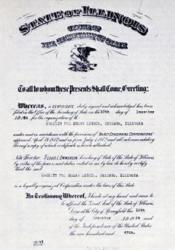Henry Gerber and The Society for Human Rights
The Society for Human Rights was established in Chicago in 1924. The non-profit organization, on December 24, 1924, was granted an official Charter from the State of Illinois. According to The Legacy Project, that is what makes it “the oldest documented homosexual organization in the nation” (The Legacy Project). In the Society’s charter, it is mentioned how its purpose was to: “[T]o promote and protect the interests of people who by reasons of mental and physical abnormalities are abused and hindered in the legal pursuit of happiness which is guaranteed them by the Declaration of Independence and to combat the public prejudices against them by dissemination of factors according to modern science among intellectuals of mature age. The Society stands only for law and order; it is in harmony with any and all general laws insofar as they protect the rights of others, and does in no manner recommend any acts in violation of present laws nor advocate any manner inimical to the public welfare” (The Legacy Project).
A year after The Society for Human Rights was created, it disbanded because Henry Gerber, the founder and important figure in the history of LGBT rights, got arrested after the publication of the Society’s second newsletter, Friendship and Freedom. Gerber today is known for being the forefather of the United States gay movement and was inspired by Germany’s Doctor Magnus Hirschfeld and his work with the Scientific Humanitarian Committee. He was originally born in 1892 in Bavaria, Germany, and in 1913, he moved to the United States. In 1917, Gerber joined the United States armed forces and continued as part of the German occupation force through 1923. When becoming familiar with the German group Bund fur Menshenrecht (Society for Human Rights), that is when he tried to establish a similar group in Chicago.
After signing the charter for The Society for Human Rights in 1924, Gerber started Friendship and Freedom, the first American publication for homosexuals. He was able to publish two issues before being shut down by the local police in 1925, a few sheer months after being officially charted by the State of Illinois. Members of the group, Gerber included, were arrested on ‘“obscenity charges, the result of a tip provided by one of the members’ wives” (National Park Service). Eventually, the charges were dropped but the legal fees bankrupted Gerber. While Gerber’s case was dismissed, his arrest cost him everything, from his life savings, his job at the post office, and everything he had to The Society for Human Rights. The group was forced to disband before it could embark on a mission to promote tolerance and understanding of homosexuality. In the brief time of the group’s existence and its small size, the Society for Human Rights, today is a precursor to the modern gay liberation movement that would not come around until around three decades later.
In 1927, he decided to reenlist for the armed forces and was posted that Fort Jay on Governors Island where he continued to write about homosexuality for several publications. Around 1930-1939, he published the periodical Contacts as a conduit for pen-pal correspondence, but also discreetly to provide a means for gay men to make connections. Not just that, he wrote several articles for the 1934 publication Chanticleer in which he defended homosexuality. During his time at Fort Jay, he got harassed and suffered beatings and blackmail only because he was gay (National Park Service). For several weeks in 1942, Gerber was held in the guardhouse at Castle Williams, and “no evidence of illegal behavior was found” (National Park Service). Although nothing was ever found, he still stayed in Castle Williams weeks after the search. Despite that, he continued with his Army career until eventually retiring in New York City with an honorable discharge in 1945. Throughout the 1950s, at a distance, he worked for the Mattachine Society in New York and the ONE Magazine. He continued by sharing his story and writing, “inspiring the movement that would eventually lead to the 1969 Stonewall riots in New York City, which catalyzed the growth of the gay rights movement nationwide” (National Park Service). Gerber’s legacy continues in the movement today for LGBT rights and serves as a reminder that Florida’s “Don’t Say Gay” bill will never stop the LGBT community from doing everything in their power to fight for what Gerber once said in ONE, a monthly gay magazine, “I realized this start was dead wrong, but after all, movements always start small... It would probably take long years to develop into anything worthwhile. Yet I was willing to slave and suffer and risk losing my job and savings and even my liberty for the ideal” (wttw).
Related Links:
Ramey, Marcus. "The Stonewall Riots, The Stonewall Uprising, The Stonewall Rebellion, or Simply, Stonewall." COVE, https://editions.covecollective.org/chronologies/stonewall-riots-stonewall-uprising-stonewall-rebellion-or-simply-stonewall.
Works Cited:
Francis, Meredith. “The Chicagoan Who Founded the Earliest Gay Rights Group in America.” wttw, 26 June 2019,
https://interactive.wttw.com/playlist/2019/06/26/henry-gerber.
Herman, Kimberly A. "Henry Gerber House National Historic Landmark.” National Park Service,
https://www.nps.gov/articles/henry-gerber-house-national-historic-landmark.htm.
“LGBT History on Governors Island.” National Park Service, 26 February 2015,
https://www.nps.gov/gois/learn/historyculture/henry-gerber.htm.
“The Society for Human Rights.” The Legacy Project,

